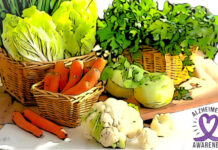Early childhood cookies are contaminated with acrylamide-suspected carcinogen and genotoxic-and are unsuitable for weaning children. This is the conclusion of a recent Italian study published in Foods. (1)
Acrylamide in infant cookies
Researchers from the Universities of Naples Federico II and Rome San Raffaele purchased 90 retail samples including ground and whole cookies, children’s cereal flour, sweet and savory snacks, and prune puree baby food. All foods were intended for infants aged 4 to 36 months.
Acrylamide is a contaminant generated by cooking starchy foods (French fries, baked goods, coffee and its substitutes) at high temperatures, as we have seen. (2) The International Agency for Research on Cancer (IARC) classifies it as a ‘probable human carcinogen‘ (Group 2A).
Analyses conducted by the researchers showed its presence in 80 percent of the foods sampled, almost exclusively in cookies, both whole and granulated, up to a maximum of 106 micrograms (μg) per kg.
Limits in EU
The toxicity of acrylamide is undoubted. Limits on the presence of this carcinogen are set by Regulation (EU) 2017/2158, which prescribes a stricter ceiling for foods approved for early childhood use:
- 40 μg /kg for processed grain-based foods,
- 150 μg /kg for rusks and cookies (compared with 350 μg /kg for general, non-baby food cookies). (3)
As can be seen, not even the worst of the samples analyzed in this study exceeded the maximum threshold. The figure, however, is not considered reassuring by researchers.
Exposure to acrylamide through weaning cookies.
Scientists measured children’s exposure to acrylamide through diet (from weaning to 18 months of age), considering cookies as the main source of the contaminant.
The conclusion is that the exposure poses no risk of neurotoxicity. Instead, ‘the probability of carcinogenic exposure is 94 percent, 92 percent and 87 percent, respectively, for children 6, 12 and 18 months old.’
In light of these data, the study authors suggest the need to delay the introduction of baked goods into children’s weaning diets.
Acrylamide and pregnancy
A source of children’s exposure to acrylamide is also the maternal body: in the gestational phase, through the placenta, and after birth through breastfeeding. (4)
Research has shown that fetuses exposed to acrylamide experience a growth slowdown, resulting in lower birth weight. (5)
A much-debated carcinogen
Food contamination with acrylamide is a hotly debated issue among consumer health protection organizations. The limits adopted by the European Commission will be re-evaluated during 2022.
SAFE Food Advocacy Europe fights for effective protection of consumers–starting with the youngest, most exposed–against this serious and unresolved food safety and public health risk. (6)
Marta Strinati
Notes
(1) Francesco Esposito, Agata Nolasco, Francesco Caracciolo, Salvatore Veloto, Paolo Montuori, Raffaele Romano, Tommaso Stasi, Teresa Cirillo (2021). Acrylamide in Baby Foods: A Probabilistic Exposure Assessment. Foods 2021, 10, 2900. https://doi.org/10.3390/foods10122900
(2) Dario Dongo, Ylenia Patti Giammello. Acrylamide, unresolved dangers. GIFT(Great Italian Food Trade), 4/15/19, https://www.greatitalianfoodtrade.it/sicurezza/acrilammide-pericoli-irrisolti
(3) Dario Dongo. Acrylamide, ABC new rules. GIFT(Great Italian Food Trade), 1/21/18, https://www.greatitalianfoodtrade.it/salute/acrilammide-abc-nuove-regole
(4) Sörgel F, Weissenbacher R, Kinzig-Schippers M, Hofmann A, Illauer M, Skott A, Landersdorfer C (2002). Acrylamide: Increased Concentrations in Homemade Food and First Evidence of Its Variable Absorption from Food, Variable Metabolism and Placental and Breast Milk Transfer in Humans. Chemotherapy 2002;48:267-274. doi: 10.1159/000069715 https://www.karger.com/Article/Abstract/69715#
(5) Talita Duarte-Salles, Hans von Stedingk, Berit Granum, Kristine B. Gützkow, Per Rydberg, Margareta Törnqvist, Michelle A. Mendez, Gunnar Brunborg, Anne Lise Brantsæter, Helle Margrete Meltzer, Jan Alexander, and Margaretha Haugen (2013). Dietary Acrylamide Intake during Pregnancy and Fetal Growth-Results from the Norwegian Mother and Child Cohort Study (MoBa). March 2013 https://doi.org/10.1289/ehp.1205396
(6) Dario Dongo. Acrylamide in food, strict limits and effective controls needed. Instances of SAFE. GIFT(Great Italian Food Trade), 23.2.22 https://www.greatitalianfoodtrade.it/sicurezza/acrilammide-nei-cibi-servono-limiti-severi-e-controlli-efficaci-le-istanze-di-safe
Professional journalist since January 1995, he has worked for newspapers (Il Messaggero, Paese Sera, La Stampa) and periodicals (NumeroUno, Il Salvagente). She is the author of journalistic surveys on food, she has published the book "Reading labels to know what we eat".







